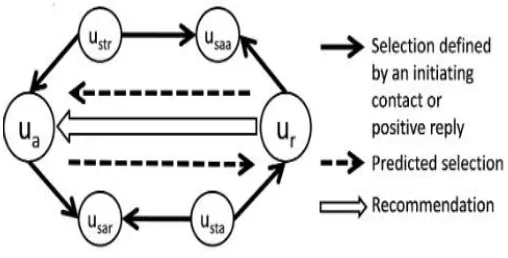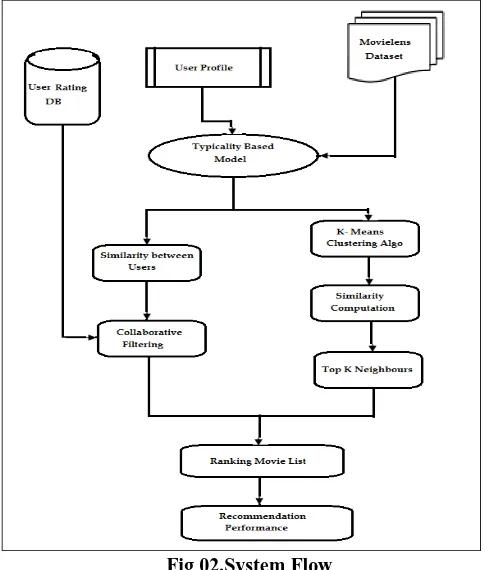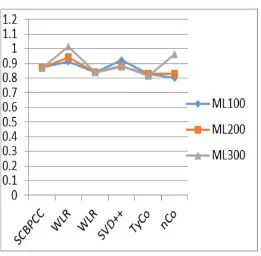Typicality-Based Collaborative Filtering
Recommendation System
Reshma U. Shinde, Dr. S.D.Raut
Department of Computer Science and Engineering, N.K.Orchid College of Engineering & Technology, Solapur,
Maharashtra, India
ABSTRACT: Collaborative filtering (CF) is an important and popular technology for recommender systems. However,
current CF methods suffer from such problems as data sparsity, recommendation inaccuracy and big-error in predictions. A distinct feature of typicality-based CF is that it finds ‘neighbors’ of users based on user typicality degrees in user groups (instead of the co-rated items of users, or common users of items, as in traditional CF)[1]. In online social networks people have a dual role as both “users” and “items”, e.g., both initiating and receiving contacts. Here the assumption of active users and passive items in traditional collaborative filtering is inapplicable. In this paper we propose a model that fully captures the bilateral role of user interactions within a social network and formulate collaborative filtering methods to enable people to people recommendation. In this model users can be similar to other users in two ways – either having similar “taste” for the users they contact, or having similar “attractiveness” for the users who contact them. We develop Social Collab, a novel neighbour-based SVD[2] algorithm to predict, for a given user, other users they may like to contact, based on user similarity in terms of both attractiveness and taste. In social networks this goes beyond traditional, merely taste-based, collaborative filtering for item selection [3].
KEYWORDS: Collaborative Filtering, Content-based Recommender System, Neighbor Selection, Recommender System,
Collaborative Filtering (CF),Object Typicality, user group and item group.
I. INTRODUCTION
Recommender systems or recommendation systems are a subclass of information filtering system that seek to predict the 'rating' or 'preference' that user would give to an item.Recommender systems have become most common in few years, and are applied in lots of applications[4]. The most popular ones are generally Bollywood - Hollywood movies, songs, news, books, research articles, search queries and products. However, there are also recommender systems for comedy, hotels, financial services, insurance services (life insurance), persons (online dating) and twitter[3].An information filtering technology, commonly used on e-commerce websites, that uses a collaborative filtering to present information on items and products that are likely to be of interest to the reader. The recommender system will use details of the registered user's profile and opinions and habits of their whole community of users and compare the information to reference characteristics to present the recommendations.An example of a recommender system is WhatShouldIReadNext.com, a site where users can enter a title of a recent book they have read and enjoyed to see recommended books that they are likely to also enjoy. Typicality based involves in finding neighbors instead of co-rated items of users. Recommender system has content based, collaborative and hybrid types for typicality finding. For user and item based collaborative filtering the measurement of similarity items or users is primary step to do this we have vector space similarity, cosine based similarity, person correlation coefficient techniques.One approach to the design of recommender systems that has seen wide use is collaborative filtering. Collaborative filtering techniques are based on gathering and analyzing a huge amount of
information on users‟ behaviors, activities or preferences and getting predicted on what users will like based on their
II. RELATED WORK
[1]Collaborative filtering (CF) is an important and popular technology for recommender systems. However, current CF
methods suffer from such problems as data sparsity, recommendation inaccuracy and big-error in predictions. In this paper, we borrow ideas of object typicality from cognitive psychology and propose a novel typicality-based collaborative filtering
recommendation method named TyCo[13]. A distinct feature of typicality-based CF is that it finds „neighbors‟ of users
based on user typicality degrees in user groups (instead of the co-rated items of users, or common users of items, as in traditional CF). To the best of our knowledge, there has been no prior work on investigating CF recommendation by combining object typicality. TyCo outperforms many CF recommendation methods on recommendation accuracy (in terms of MAE) with an improvement of at least 6.35% in Movie lens Data set, especially with sparse training data (9.89% improvement on MAE) and has lower time cost than other CF methods[11].
[2]To solve this problem, the recommendation system based on collaborative filtering is applied to the simulation resource
management system, which can recommend the most relative simulation resource to the user according to user‟s previous
preference. From this paper we referredAfter analyzing the necessity of combining the recommendation system with the Simulation resource system, the simulation resource recommendation system is designed and realized. The realization includes three main procedures: collecting user preferences, finding neighbor users, recommending simulation resources.
The recommendation system collects users‟ grading on used simulation resources as user preferences, and uses the Pearson
correlation to calculate the similarity between users and then finds out the neighbor users.Our proposed method, a collaborative filtering method to provide an enhanced recommendation quality derived from user-created tags. Collaborative
tagging is employed as an approach in order to grasp and filter users‟ preferences for items. In addition, we explore several
advantages of collaborative tagging for data sparseness and a cold-start user. These applications are notable challenges in collaborative filtering[13].
[3]Empirical experiments using a real dataset from del.icio.us. Experimental results show that the proposed algorithm offers
significant advantages both in terms of improving the recommendation quality for sparse data and in dealing with cold-start users as compared to existing work.Recommendation systems are widely used to recommend products to the end users that are most appropriate online book selling websites now-a-days are competing with each other by many means. Recommendation system is one of the stronger tools to increase profit and retaining buyer. The book recommendation
system must recommend books that are of buyer‟s interest. This paper presents book recommendation system based on
combined features of content filtering, collaborative filtering and association rule mining[4].
[4]The hybrid recommender system with temporal information is best method from all methods which we have studied.
Because it constructs offline to make the recommendation system to recommend item for a user within user bearable time which will also reduce the computational time. Also, it solves scalability, sparsity and cold start issue and provides final recommendation quickly and accurately.Recommender systems provide an important response to the information overload problem as it presents users more practical and personalized information services. Collaborative Filtering technique is the most successful in the recommender systems field. Collaborative filtering creates suggestions for users based on their
neighbor‟s preferences. But it suffers from poor accuracy, scalability and cold start problems[12].
[5]The tremendous growth of the number of customers and products in recent years poses some key challenges for
recommender systems in which high quality recommendations are required and more recommendations per second for millions of customers and products need to be performed. Thus, the enhancement of scalability and efficiency of collaborative filtering (CF) algorithms become progressively more important and difficult.[9] This paper focuses on study of different collaborative filtering algorithms taking into consideration the scalability issue. The different algorithms studied are cluster based, item based and context based.There are many recommendation system for tour packages, but they fail to create a package that suite the customer need. The unique characteristics of travel data are area of interest, session and travel mode. The tour spots are distributed in many geographical locations.
[6]The topic extraction is conditioned on both the tourists and the intrinsic features like locations travel seasons, mode of
recommendation techniques for travel package recommendation by including tourist relationships, TRAST model is used as an effective evaluation for travel group formation[8].
III. EXSISTING APPROACH
Recommendation process plays an important role in many applications as W.W.W. Recommender systems uses the users, items, and ratings information to predict how other users will like a particular item. An important response to the information overload problem is provided by the recommender system, as it presents users more personalized and practical information services such as profile sharing. In the recommender systems field Collaborative Filtering (CF) is one of the most successful technique. For users based on their neighbor’s preferences Collaborative filtering creates better suggestions. Current CF suffers from poor accuracy, scalability, data sparsity and big-error prediction. As the number of users and items in recent years are growing rapidly poses some key challenges for recommender systems. In this Project, we borrow ideas of object typicality from cognitive psychology and propose a novel Object typicality-based collaborative filtering recommendation method (TYCO), and personalize Recommendation based model on Location, Relation of user or customers[7]. It outperforms many CF recommendation methods on recommendation accuracy in MovieLens data set
IV. NECESSITY OF PROPOSED SYSTEM
This proposed system necessary for following:
1. To provides and study of utilizing information for the personalized movie recommendation based on user interest.
2. To Finds the “neighbors” of users by measuring users’similarity based on typicality degrees of user in usergroups, which differentiates it from previous methods.
3. To works well even with data sets.
4. To reduce the number of big-error predictions. 5. To improves the accuracy of predictions.
6. System also responsible for making friendship with similar user.
V. SYSTEM ARCHITECTURE
The above figure shows the setup of proposed system. The description for the above figure is given below. I. Web Server receives user data from browser
II. Clustering algorithm retrieve the data from dataset
III. At runtime user profile support to personalize the recommendation by collaborative filtering.
IV. According to the user profile and interest system gives the personalized recommendation of movies from movie lens Dataset.
V. User query and interest will process on web server
VI. System will compute the similarity between group of users by filtering The Application Server takes the computation and predicts the similarity base on rating and reviews.
VII. System also helps to user to send friend request and messaging to similar area of interest holder users.
In social networks, “items” as the recipients of actions are also users who are actively participating in social interactions. When they a re contacted by other users, they can make different responses, either positive or negative. Therefore, traditional CF is not applicable to people recommendation since it only considers the taste of one side (users) and neglects the other (items). The recommender framework needs to be extended to handle the bilateral nature of such interactions in people recommendation.
Fig. 2Collaborative Filtering for People to People Recommendation
SocialCollab: Modelling Bilateral Decisions Just because the active user likes a user does not mean a successful match since the liked user may not like the active user. This requires that the liked user also likes the active user. The point here is that only when ua likes ur and also ur likes ua can an interaction be a success. Only in this case, ur should be recommended to ua.
VI. RECOMMENDER SYSTEMS MECHANISM
To model this behaviour, following traditional collaborative filtering assumptions, we define the following two assumptions based on user taste:
1. If people with similar taste to ua like ur, ua will like ur; 2. If people with similar taste to ur like ua, ur will like ua.
This can be restated in terms of user attractiveness:
3. If ua likes people with similar attractiveness to ur, ua will like ur; 4. If ur likes people with similar attractiveness to ua, ur will like ua,
ur, or equivalently, when people with similar taste to ur like ua and people with similar taste to ua like ur. More formally, for a predicted successful interaction between ua and ur: denoted ua _! ur, there are two conditions to be fulfilled:
5. The attractiveness of the recommended user should match the taste of the active user, which will facilitate initiation of the interaction from the active user to the recommended user. In a user-based approach, we define this as:
………..(5)
Algorithm
There have been many works on recommender systems and most of these works focus on developing new methods of recommending items to user’s .The objective of recommender systems is to assist users to find out items which they would be interested in. Items can be of any type, such as movies, jokes, restaurants, books, news articles, and so on. Currently, recommendation methods are mainly classified into collaborative filtering (CF), content based (CB), and hybrid methods. For the reason that we are focusing on proposing a new CF method, we will introduce the related works about CF methods in more details. -Based Recommender Systems. The descriptions of items are analyzed to identify interesting items for users in CB recommender systems. Based on the items a user has rated, a CB recommender learns a profile of user’s interests or preferences[2]. According to a user’s interest profile, the items which are similar to the ones that the user has preferred or rated highly in the past will be recommended to the user. For CB recommender systems, it is important to learn users’ profiles. Various learning approaches have been applied to construct profiles of users. For the reason that CF methods do not require well-structured .There are two kinds of CF methods, namely User-based CF approach and item-based CF approach. User-based CF approach first finds out a set of nearest “neighbors” (similar users) for each user, who share similar favorites or interests. Then, the rating of a user on an unrated item is predicted based on the ratings given by the user’s “neighbors” on the item.
Explanation-
For the reason that CF methods do not require well-structured .There are two kinds of CF methods, namely User-based CF approach and item-based CF approach[2]. user-based CF approach first finds out a set of nearest “neighbors” (similar users) for each user, who share similar favorites or interests. Then, the rating of a user on an unrated item is predicted based on the ratings given by the user’s “neighbors” on the item.
VII. EXPERIMENTAL SETUP
Fig. 03A Comparison of State-Of-The-Art Methods on MAE
From the projectwork someanalysis between different techniques has been made. The following table shows the comparison with state-of-the art methods on MAE which includes SCBPCC, WLR, CBT, SVD++, TyCo[13] .
VIII. CONCLUSION
REFERENCES
[1] BadrulSarwar, George Karypis, Joseph Konstan, and John Riedl,”Item Based Collaborating Filtering Recommendation Algorithms”,ACM, 2001 Hong Kong.
[2] Gouthami, Golamari. Jose Mary and PulluriSrinivasRao, “RankingPopular Items by Naive Bayes Algorithm”, International Journal ofcomputer science and information technology (IJCSI) Vol 4. No 1,Feb 2012, pp. 147-163.
[3] GediminasAdomavicius, YoungOk Kwon” Improving AggregateRecommendation. Diversity Using Ranking-Based Techniques”,IEEE Transactions On Knowledge And Data Engineering, Vol. 24,No. 5, May 2012.
[4] Xiang Cui,Guisheng Yin,” Method of collaborative filtering basedon uncertain user interests cluster”, Journal Of Computers,Vol.8,No.1,January 2013, pp. 186-193.
[5] Jian Chen, Jin Huang, Huaqing Min, “Easy Recommendation Basedon Probability Model”, Proceeding in Fourth InternationalConferences on Semantics, Knowledge and Grid, IEEE, 2008, pp441-444.
[6] ToineBogers, “Movie Recommendation uses Random Walk overContextual Graph”, 2010.
[7] Min,Jie tang and Juanzi Li, ”Typicality-based Collaborative FilteringRecommendation”,Ieee Transaction On Knowledge And DataEngineering, Vol. 26, No. 3, March 2014, pp. 766-779.
[8] Ralf Krestel, peter Fankhauser, Wolfgang Nejdl, “Latent DirichletAllocation for tag Recommendation”, ACM 2009. [9] Jun Hu, Bing Wang, Yu Liu, De-Yi Li,”Personalized TagRecommendation 2005
[10] Social Influence“, Journal Of Computer Science And Technology27(3): 527-540 May 2012.
[11] AnastationNoulas, Salvatore Seellaoto, Neal Lathia, CeciliaMascolo, “Random Walk Around the City: New VenueRecommendation in Location-Based Social Networks”, 2012.
[12] Yi Cai, Ho-fungLeungy, Qing Li, Jie Tang and Juanzi LiRecommendation Based On Object Typicality Project No. City U117608, October 2010. [13] A.Ganesh ,P.M Jhansi Rani “Typicality based collaborating filtering recommendation system.” International Journal of Emerging Trends in Engineering Research (IJETER), Vol. 3 No.6, Pages : 140- 146 (2015)



